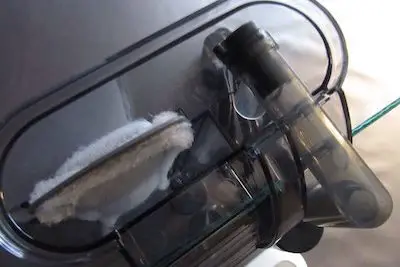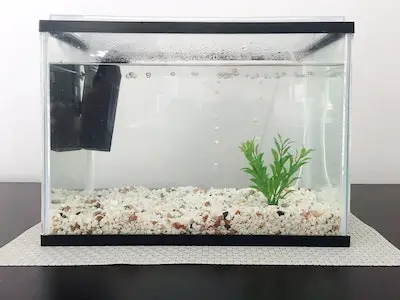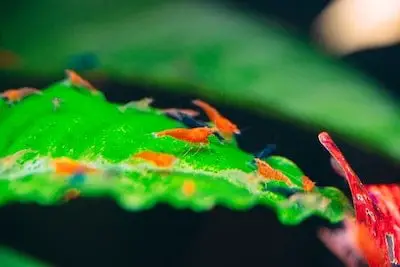Shrimp Tank Water Change: Everything You Need to Know
Part of caring for your shrimp is ensuring that their water is changed regularly to avoid nitrate build-up in their aquarium.
As much as this is a necessary aspect of shrimp care, these aquatic creatures are not fans of sudden changes in water conditions.
Therefore, understanding when and how to perform a shrimp tank water change is a key component of keeping these tiny animals happy and healthy.
Here’s everything you need to know about conducting a shrimp tank water change.

Contents
Do I Need to Change the Water in My Shrimp Tank?
The water in a shrimp tank needs to be changed regularly to prevent the build-up of nitrates.
Shrimp excrete ammonia which is later converted to nitrites.
The nitrogen cycle established in the tank is how ammonia is removed from the water. However, the nitrates produced will remain untouched, so shrimp tank water changes are crucial.
They ensure that these toxins are extracted from the aquarium before reaching dangerous levels.
How Often Should I Do Water Changes in My Shrimp Tank?
The water in a shrimp tank needs to be changed every seven to 14 days.
There are very rare instances where you can get away with a longer duration without changing the water. One example is if there are many aquatic plants in the aquarium that will consume the nitrates in the tank.
It’s vital to have a TDS (Total Dissolved Solids) meter to measure the level of organic and inorganic compounds in the water.
Too much TDS can cause stress to the tank’s inhabitants, affecting their growth and breathing. Too little, and your shrimp may have a hard time maintaining their exoskeleton.
The right amount of TDS depends on the water’s salt profile. When TDS levels fall out of the safe range, it’s time for a shrimp tank water change.
How to Do Water Changes for Shrimp
Shrimp are sensitive to sudden changes in water conditions. For this reason, both cycling the water when you first get a tank and carrying out water changes are essential.
First, you will need to age and treat the water you intend to add to the tank to not harm the shrimp.
Other necessary steps include adding minerals to the water and a water temperature check.
Here’s how to go about changing the water in a shrimp tank.
1. Age the Water
It’s vital to ensure that the water you want to add to the aquarium sits for at least 24 hours before adding it to a shrimp tank.
This aging allows it to get to the same temperature as the tank water. It also gives the chlorine in the tap water a chance to escape. Chlorine is likely to harm your shrimp.
2. Treat the Water
It would help if you also used a de-chlorinator to remove other chlorine compounds before adding the water to the tank.
Most dechlorinating products will only require about 10 to 15 minutes to get the job done. Be warned that they may have an unpleasant rotten-egg smell as they contain a compound called sodium thiosulfate.
Dechlorinating products may smell terrible, but they are perfectly safe for your shrimp.
3. Add Minerals
Adding minerals to the water ensures that your shrimp have all the necessary chemicals to maintain their exoskeletons and normal bodily functions.
Shrimp are aquatic creatures, meaning the tank’s conditions need to match those found in their natural environment closely.
Oceans, lakes, and rivers are not made of pure water but contain chemicals and compounds suitable for the animals that call these places home.
When performing a shrimp tank water change, remember that you are not aiming for pure water but for water that is most like the shrimp’s natural habitat.
4. Check the Temperature
Ensure that your water temperature is the same as that of your tank.
Changing the temperature of the water in the aquarium can cause molting. Molting females will start dropping their eggs, which is not ideal.
5. Drain the Tank
During a shrimp tank water change, you should only replace 10% – 15% of the water in the tank. This prevents the shrimp from experiencing sudden water changes.
Mark the tank a tenth of the way from the top, then siphon the water.
6. Add Water
Add the prepared water slowly to avoid stressing the shrimp.
Refill the tank with only a few liters a minute to make the shrimp tank water change a gradual experience. This will have the most negligible impact on the shrimp.
Tips for Doing Shrimp Tank Water Changes
Performing a shrimp tank water change for the first time can be a little daunting. Once you get the hang of it, though, you will be handling the whole process like a pro.
These tips will help you navigate a shrimp tank water change with minimal stress to your shrimp.
Ideal Water Conditions
When checking the pH and water temperature, ensure that these parameters are suitable for your shrimp.
These tiny creatures are most comfortable in 70 to 76 degrees Fahrenheit conditions. They prefer to breed in water with a pH of 6.8 to 7.5.
Prevent Contamination
Shrimp are very sensitive to various metals such as copper.
When changing their water, make sure that the liquid does not come into contact with any contaminants.
Tools like the bucket used in this procedure should only be utilized for shrimp tank water changes to prevent contamination.
Consistency
Note down how much mineral you used to get the ideal water hardness.
Consistency is vital with shrimp, so you should add the same amount of minerals to the water with each shrimp tank water change.
Behavior Changes
Shrimp are sensitive to water changes. Failure to adapt to the new environment after a water change will cause the shrimp to jump around the tank to escape the uncomfortable habitat.
If you notice your shrimp trying to make their way out of your aquarium, check the water for contamination, elevated pH, increased temperature, or other markers that may be harmful to the creatures.
In Summary
Like all living creatures, shrimp produce waste. If not removed from the tank, the nitrates they excrete can turn their water toxic.
Therefore, a shrimp tank water change is crucial in ensuring the health and well-being of the shrimp.
Refreshing their environment once every seven to 10 days will keep your tank toxin-free and your shrimp happy.





